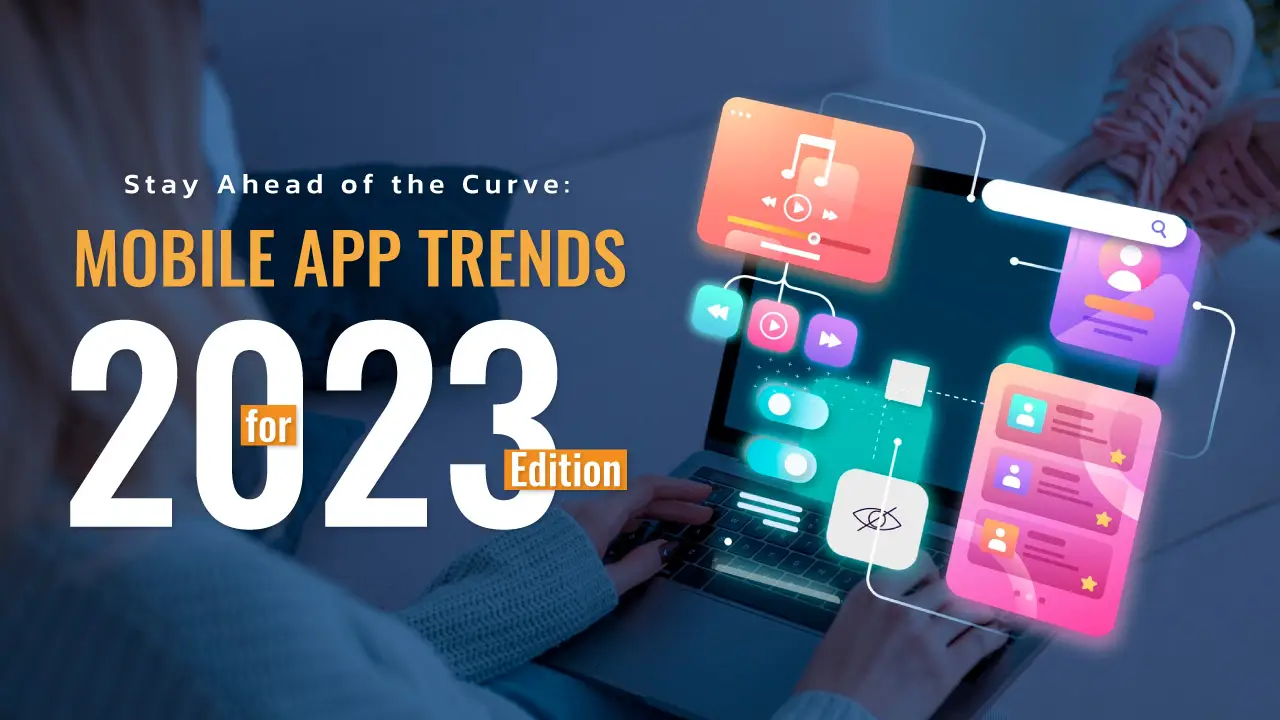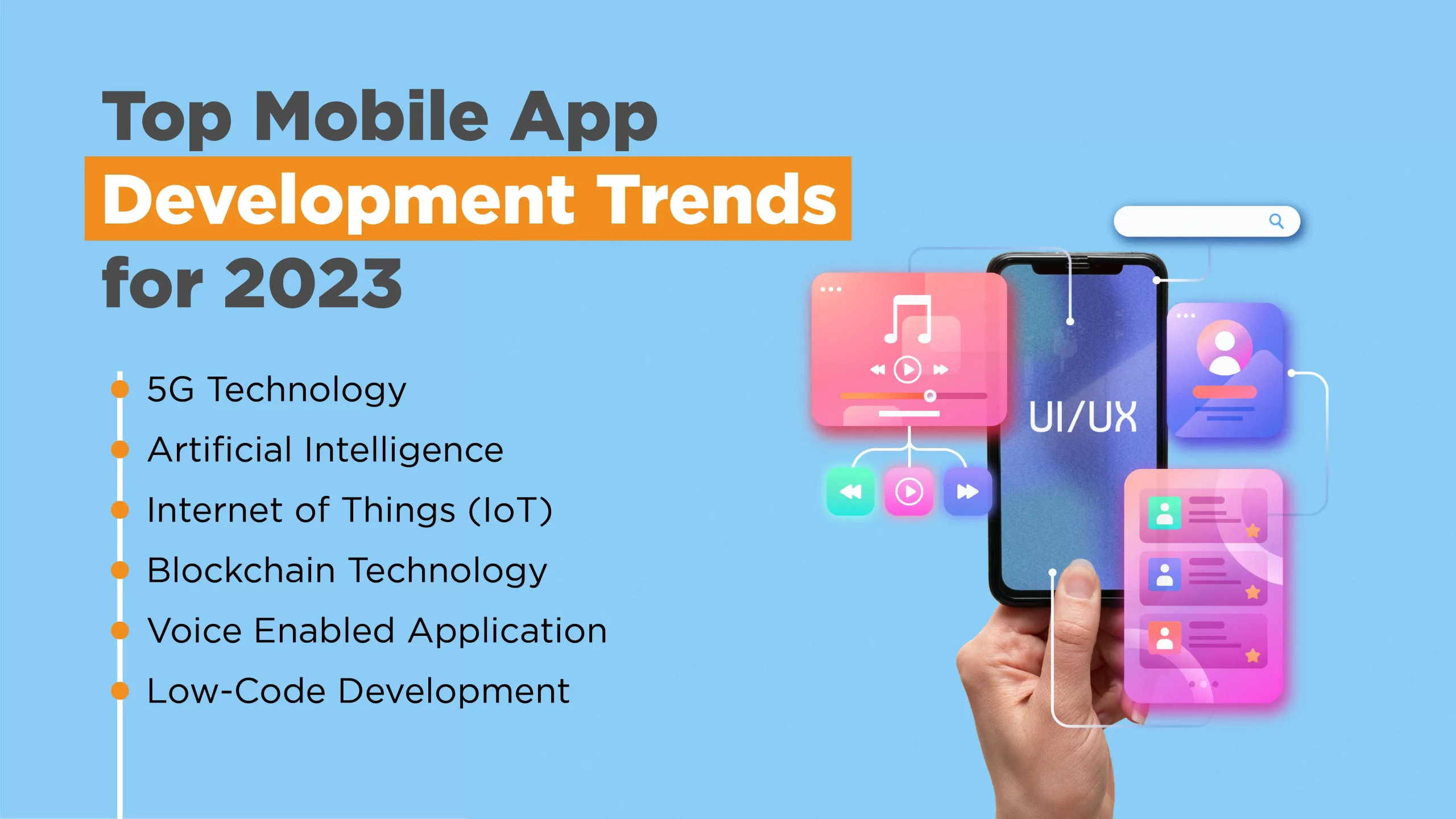Stay Ahead of the Curve: Mobile App Trends for 2023 Edition
The mobile app industry is constantly evolving, and staying ahead of the curve is essential for app developers and businesses. With the advent of new technologies and changing user behavior, it’s important to keep an eye on the latest trends in mobile apps to ensure that your app remains relevant and appealing to users.

As we approach 2023, there are a few key trends that are likely to shape the mobile app landscape. From the continued growth of augmented reality to the increasing emphasis on privacy and security, app developers will need to keep up with these trends to create successful and sustainable apps.
According to a report by App Annie, a leading mobile app analytics and market data provider, global consumer spending on mobile apps reached $143 Billion in 2020, a 20% increase from the previous year. The report also predicts that consumer spending on mobile apps will continue to grow at a compound annual growth rate of 12% from 2020 to 2023, reaching $270 Billion by the end of 2023.
In this blog, we’ll explore some of the most important mobile app trends to watch out for in 2023. Whether you’re a developer, marketer, or business owner, understanding these trends will be crucial for staying ahead of the competition and delivering a top-notch user experience. So, let’s strap in and get ready for a glimpse into the future of mobile apps!
Top Mobile App Development Trends for 2023

- 5G Technology: With the widespread rollout of 5G networks, mobile app developers will be able to create more sophisticated and high-performance applications that rely on low-latency, high-bandwidth connectivity. It could lead to the development of new categories of apps, such as real-time augmented reality applications, immersive gaming experiences, and virtual reality training applications.
- Increased Network Speed & Capacity: 5G technology is designed to provide significantly faster network speeds and increased capacity compared to 4G. It will enable mobile users to access data and content more quickly and efficiently, which will drive the development of new applications and services that require high-speed connectivity.
- Low Latency: 5G networks are expected to offer much lower latency compared to 4G networks, which will enable real-time applications such as autonomous vehicles, remote surgery, and smart city applications.
- Improved Connectivity: 5G networks are designed to support a large number of connected devices simultaneously. It will enable the Internet of Things (IoT) to become more widespread, leading to the development of more connected devices and applications.
- Enhanced User Experience: With faster network speeds and lower latency, mobile users will have a better experience when using applications such as video streaming, online gaming, and augmented reality. 5G technology will enable more sophisticated and immersive applications that require high-speed connectivity and low latency.
- Economic Growth: The rollout of 5G networks is expected to drive economic growth by enabling new business models and services. It could lead to the creation of new jobs and the development of new industries, such as smart cities, autonomous vehicles, and industrial automation.
- Artificial Intelligence: AI-powered applications are becoming increasingly popular, and this trend is expected to continue in 2023. Machine learning and natural language processing capabilities will enable apps to personalize user experiences, automate routine tasks, and provide better recommendations and insights.
- Enhanced Personalization: AI-powered applications are becoming increasingly sophisticated in terms of personalization. In 2023, we can expect more applications that leverage machine learning algorithms to analyze user data and provide more personalized recommendations, services, and products.
- Automation: AI-powered automation is already transforming many industries, and this trend is expected to continue in 2023. With advances in natural language processing and computer vision, more jobs are expected to be automated, leading to increased efficiency, cost savings, and productivity.
- Improved Healthcare: AI is already being used in healthcare to improve diagnosis, treatment, and patient outcomes. In 2023, we can expect more advanced AI-powered medical devices, telemedicine, and personalized treatment plans, improving access to healthcare for people around the world.
- Smart Cities: AI is expected to play a significant role in creating smart cities. In 2023, we can expect more AI-powered applications and infrastructure for traffic management, energy efficiency, public safety, and waste management.
- Cybersecurity: With the increasing number of cyber threats, AI-powered security solutions are becoming more important. In 2023, we can expect more AI-powered security tools, such as threat detection and response systems, to help protect businesses and individuals from cyber attacks.
- Environmental Sustainability: AI could play a significant role in helping to address climate change and environmental sustainability. In 2023, we can expect more AI-powered applications and technologies that support renewable energy, resource optimization, and environmental monitoring.
- Internet of Things (IoT): The IoT market is growing, and mobile apps will continue to play a significant role in this space. App developers will create more IoT-enabled applications, including smart home systems, wearables, and industrial automation solutions.
- Increased adoption: The adoption of IoT devices has been increasing steadily over the years and will continue in the future. As more people become familiar with the benefits of IoT, they are likely to embrace it more readily.
- Enhanced connectivity: The rollout of 5G technology is expected to provide faster and more reliable connectivity, which will be critical for the effective functioning of IoT devices.
- Greater automation: IoT devices can help automate various tasks and processes, making them more efficient and reducing the need for human intervention. It can result in cost savings and increased productivity.
- Improved data analytics: IoT devices generate vast amounts of data, which can be analyzed to provide insights into various aspects of business operations or daily life. As data analytics technology continues to advance, these insights will become even more valuable.
- Enhanced security: As IoT devices become more common, there will be an increased focus on ensuring their security. It will lead to the development of better security protocols and technologies, which will make IoT devices safer to use.
- Blockchain Technology: Blockchain technology is finding more applications in various industries, and mobile app development is no exception. Blockchain-powered apps can offer increased security, transparency, and accountability, and with many more miracles, continue to grow in 2023.
- Security: Blockchain is a decentralized system that provides an immutable and tamper-proof ledger of transactions. It makes it very difficult for hackers to manipulate data, ensuring high security.
- Transparency: Blockchain technology allows for transparent and auditable transactions. It makes it useful in industries such as finance, healthcare, and supply chain management, where transparency is critical.
- Efficiency: Blockchain technology enables fast, secure, and cost-effective transactions without intermediaries, which reduces transaction time and costs.
- Decentralization: Blockchain technology enables decentralization, which means that no central authority controls the network. This makes it ideal for industries where trust is essential, such as finance, insurance, and real estate.
- Adoption: Blockchain technology has gained widespread adoption across various industries, including finance, healthcare, supply chain management, and more. As more businesses and industries adopt blockchain technology, it is likely to become even more prevalent.
- Voice-Enabled Applications: With the rise of smart speakers and voice assistants, voice-enabled applications are becoming increasingly popular. In 2023, we can expect more apps that rely on voice commands, including virtual assistants, voice-controlled games, and voice-enabled home systems.
- Decentralization: The key advantage is decentralization meaning it is not controlled by a single entity or organization. It makes it more secure and resistant to attacks or manipulation.
- Security: The use of cryptographic algorithms and consensus mechanisms in blockchain technology ensures that the data stored on the blockchain is tamper-proof and immutable, making it more secure than traditional databases.
- Transparency: The decentralized and open nature of blockchain technology allows for greater transparency, making it easier to track and verify transactions and data.
- Efficiency: The use of smart contracts and automation in blockchain technology can streamline processes and reduce costs, making it more efficient than traditional systems.
- Innovation: Blockchain technology is still in its early stages, and there is much room for innovation and development in the space. As more companies and industries adopt blockchain technology, new use cases and applications will emerge.
- Low-Code Development: Low-code development platforms are becoming more popular, allowing developers to create applications more quickly and efficiently. In 2023, we can expect more mobile app development to be done using low-code platforms, enabling businesses to bring their apps to market faster and at a lower cost.
- Increasing demand for digital transformation: Many companies are recognizing the need to digitize their operations to stay competitive and meet evolving customer expectations. Low-code development can help accelerate the pace of digital transformation by enabling organizations to rapidly develop and deploy new applications and features.
- Shortage of skilled developers: The demand for software developers continues to outstrip supply, which makes it difficult for organizations to find the talent they need to build and maintain their applications. Low-code development can help bridge this gap by enabling business users with limited coding experience to create and deploy applications.
- Advances in low-code technology: Low-code development platforms are becoming more sophisticated and powerful, with new features and integrations that make it easier for developers to build complex applications. As these platforms continue to evolve, they may become more appealing to organizations looking for a faster, more streamlined development process.
In conclusion, mobile app trends are constantly evolving, driven by advancements in technology and changes in consumer behavior. As we look ahead to 2023, several trends are shaping the mobile app landscape. These include the continued growth of mobile gaming, the increasing use of augmented reality and virtual technologies, and the integration of artificial intelligence and machine learning into mobile apps. Additionally, the popularity of mobile commerce is expected to rise, as consumers increasingly turn to their mobile devices to shop and make purchases. As mobile devices continue to become an integral part of our daily lives, it is clear that the mobile app industry will remain a dynamic and exciting space in the coming years.
By staying up-to-date with the latest technological advancements and consumer behavior patterns, Black Widow Tech can develop mobile apps that cater to the needs and preferences of users in the coming years.
For instance, we are experienced in developing mobile games that leverage emerging technologies such as AR & VR. These games provided users with immersive and engaging experiences, helping to drive engagement and user retention. Moreover, we have integrated AI and ML capabilities into mobile apps, enabling personalized and predictive user experiences. It can include features such as intelligent recommendations, personalized content, and chatbots that provide instant support and assistance.
In summary, we can help in meeting the mobile app trends of 2023 by leveraging emerging technologies, integrating AI and machine learning, and focusing on providing personalized and seamless user experiences.
